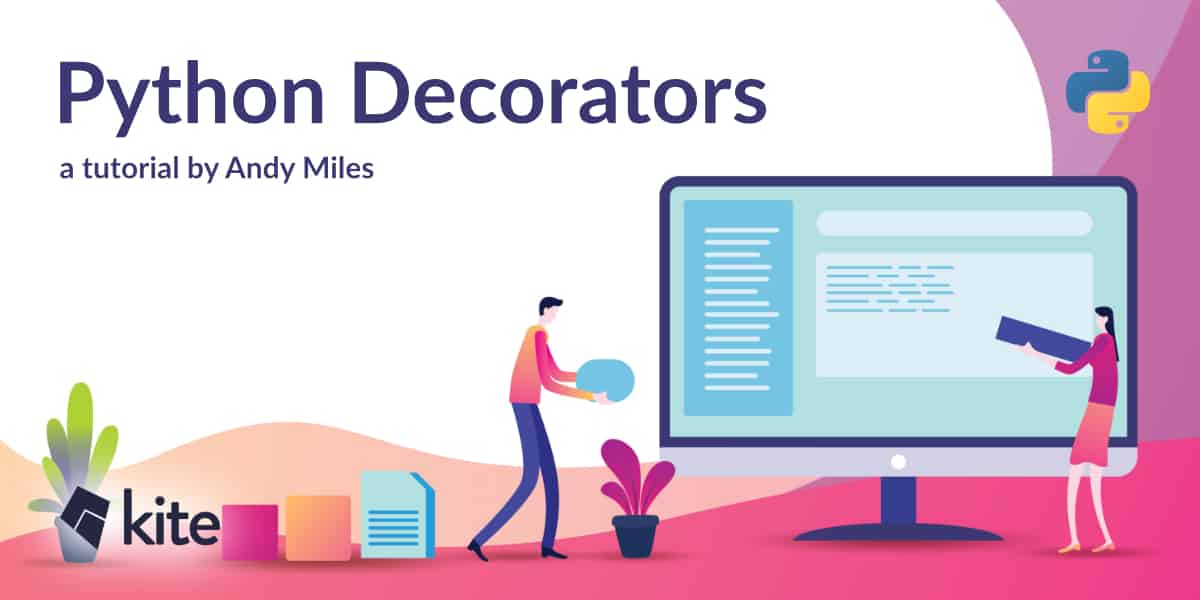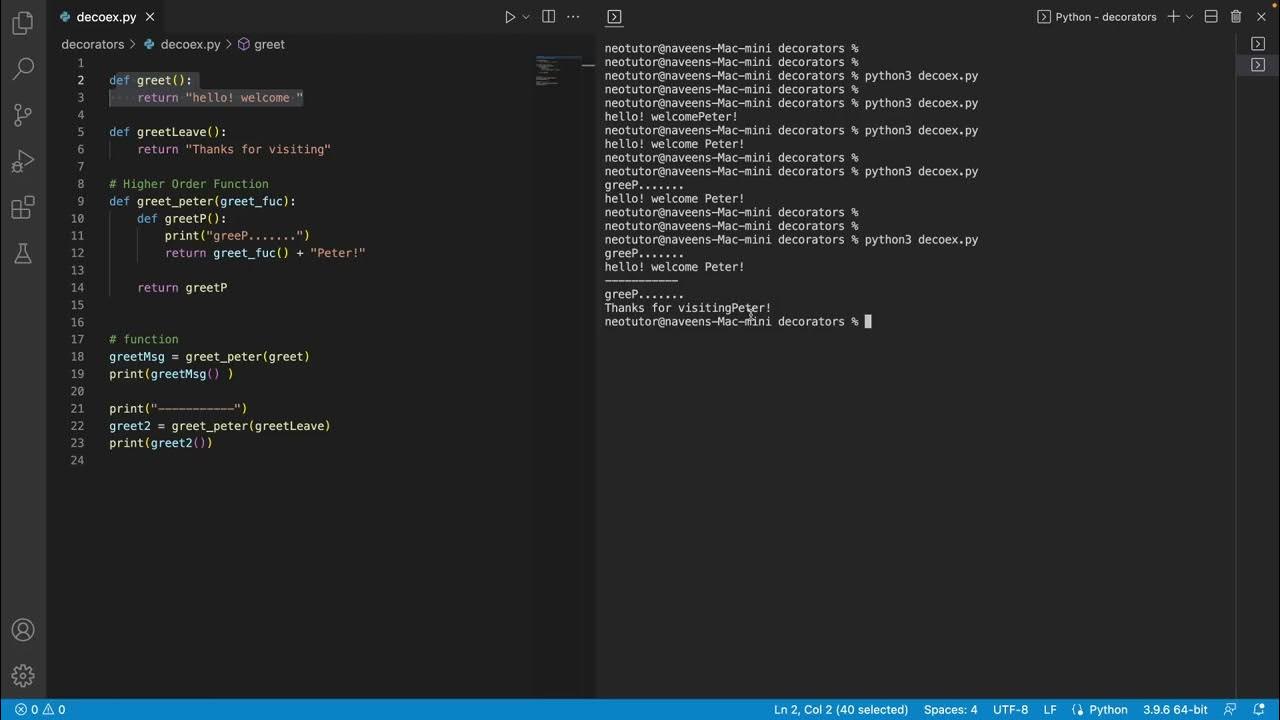Python Decorators: When and Why to Use Them

Understanding Python Decorators

Python decorators are a powerful tool in Python's arsenal, allowing developers to modify or enhance functions or methods without altering their core functionality. They are often used to extend or modify the behavior of functions in a clean and readable way. But when should you use decorators, and why are they beneficial?
What are Decorators?

A decorator in Python is a function that takes another function as an argument and returns a new function that usually extends the behavior of the original function without explicitly modifying it. Here's a simple example to illustrate:
def my_decorator(func):
def wrapper():
print("Something is happening before the function is called.")
func()
print("Something is happening after the function is called.")
return wrapper
@my_decorator
def say_hello():
print("Hello!")
say_hello()In this example:
- The
my_decoratorfunction defines a wrapper function that prints messages before and after the original function is called. say_hellois decorated with@my_decorator, which means whensay_hellois called, it's actuallywrapperthat runs, including the originalsay_hellofunction within it.
Why Use Decorators?

Modularity and Code Reusability

Decorators enhance modularity in your code. By defining common patterns of behavior once, you can reuse this behavior across different parts of your application:
- Logging: You can log function calls, their arguments, or their execution time with a decorator.
- Authorization and Authentication: Decorators can check user permissions or authentication before executing a function.
- Timing Functions: They can be used to measure the performance of functions.
🚀 Note: Using decorators for logging or timing is not just about writing less code, but about making your code more readable and maintainable.
Clarity and Readability

Decorators make your code cleaner:
- By using the
@syntax, you separate concerns, making it easy to understand what the function does and what additional behavior it inherits.
Aspect-Oriented Programming

Decorators can help you implement aspects like logging or security policies without cluttering your main code with unrelated logic:
@timed
@logged
def some_long_function():
# complex logic hereIn this example, decorators handle timing and logging, keeping the function body focused on its primary task.
When to Use Decorators?

When You Need to Modify Function Behavior

If you find yourself frequently repeating the same code before or after calling a function, a decorator is a good candidate:
- Error handling: Decorators can manage exceptions, logging errors, or even retry failed operations.
- Cache Result: Decorators can store function results to avoid recalculation for the same input.
When Applying Cross-Cutting Concerns

Cross-cutting concerns are those behaviors that are needed across multiple functions but aren't the primary function of those methods:
- Data Validation: You can validate input or output of functions.
- Tracking Usage: To keep track of how often or how long functions are used.
When You Want to Implement Factory Functions

Decorators can be used to create different versions of functions or classes based on some input parameters:
from functools import wraps
def repeat(times):
@wraps(func)
def wrapper(*args, kwargs):
for _ in range(times):
result = func(*args, kwargs)
return result
return wrapper
@repeat(times=3)
def greet(name):
print(f"Hello, {name}!")Here, repeat is a decorator factory that returns a decorator that repeats a function call times times.
When You Need to Change Function Signature

If you need to modify how a function is called or how it receives its arguments, decorators are ideal:
- Adding Optional Arguments: A decorator can add default or optional parameters.
- Enforcing Type Hints: Ensuring function arguments and return types are of a specific type.
Examples and Best Practices

Logging

Here's how you can use decorators to log function calls:
from functools import wraps
def log(func):
@wraps(func)
def wrapper(*args, kwargs):
print(f"Calling {func.__name__}")
result = func(*args, kwargs)
print(f"{func.__name__} returned {result}")
return result
return wrapper
@log
def add(x, y):
return x + y
add(2, 3)This will print logging messages before and after the function execution.
Performance Measurement

To measure how long a function takes to execute:
import time
from functools import wraps
def measure_time(func):
@wraps(func)
def wrapper(*args, kwargs):
start = time.time()
result = func(*args, kwargs)
end = time.time()
print(f"{func.__name__} took {end - start:.4f} seconds to run")
return result
return wrapper
@measure_time
def fibonacci(n):
if n <= 1:
return n
return fibonacci(n-1) + fibonacci(n-2)
fibonacci(30)Summary of Key Points

Decorators provide a way to modify or extend the behavior of functions or methods in a modular and clean manner:
- They promote separation of concerns, making your code more readable and maintainable.
- Use decorators when you want to apply reusable behavior across multiple functions.
- They are particularly useful for implementing cross-cutting concerns like logging, timing, and validation.
- Decorators can change how functions are called or handle their return values without changing their original implementation.
By mastering decorators, you gain tools to write more elegant, flexible, and maintainable Python code, which can significantly improve both development productivity and the maintainability of your projects.
What is the benefit of using decorators over regular function modification?

+
Decorators keep the core logic of your function clean and separate the modification or extension logic into its own space. This separation enhances readability, maintainability, and reusability.
Can decorators be used with class methods?
+Yes, decorators can be applied to both static methods and instance methods within a class. For instance methods, you might need to pass self correctly in the decorator wrapper.
Is it possible to stack multiple decorators on a single function?
+Absolutely! Decorators can be stacked, and they apply from bottom to top. Each decorator modifies the output of the previous one in the chain.